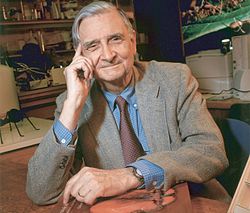History

Germ plasm
In 1892, the Austrian biologist August Weismann proposed that multicellular organisms consist of two separate types of cell: somatic cells, which carry out the body's ordinary functions, and germ cells, which transmit heritable information. He called the material that carried the information, now identified as DNA, the germ plasm, and individual components of it, now called genes, determinants which controlled the organism. [9] Weismann argued that there is a one-way transfer of information from the germ cells to somatic cells, so that nothing acquired by the body during an organism's life can affect the germ plasm and the next generation. This effectively denied that Lamarckism (inheritance of acquired characteristics) was a possible mechanism of evolution. [10] The modern equivalent of the theory, expressed at molecular rather than cellular level, is the central dogma of molecular biology. [11]
Eugenics

Early ideas of biological determinism centred on the inheritance of undesirable traits, whether physical such as club foot or cleft palate, or psychological such as alcoholism, bipolar disorder and criminality. The belief that such traits were inherited led to an attempt to solve the problem with the eugenics movement. This was led by a follower of Darwin, Francis Galton (1822–1911), who advocated forcibly reducing breeding among people with those traits. By the 1920s, many U.S. states enacted laws permitting the compulsory sterilization of people considered genetically unfit, including inmates of prisons and psychiatric hospitals. This was followed by similar laws in Germany, and throughout the Western world, in the 1930s. [13] [4] [14]
Scientific racism
Under the influence of determinist beliefs, the American craniologist Samuel George Morton (1799–1851), and later the French anthropologist Paul Broca (1824–1880), attempted to measure the cranial capacities (internal skull volumes) of people of different skin colours, intending to show that whites were superior to the rest, with larger brains. All the supposed proofs from such studies were invalidated by methodological flaws. The results were used to justify slavery, and to oppose women's suffrage. [4]
Heritability of IQ
Alfred Binet (1857–1911) designed tests specifically to measure performance, not innate ability. From the late 19th century, the American school, led by researchers such as H. H. Goddard (1866–1957), Lewis Terman (1877–1956), and Robert Yerkes (1876–1956), transformed these tests into tools for measuring inherited mental ability. They attempted to measure people's intelligence with IQ tests, to demonstrate that the resulting scores were heritable, and so to conclude that people with white skin were superior to the rest. It proved impossible to design culture-independent tests and to carry out testing in a fair way given that people came from different backgrounds, or were newly arrived immigrants, or were illiterate. The results were used to oppose immigration of people from southern and eastern Europe to the USA. [4]
Human sexual orientation
Human sexual orientation, which ranges over a continuum from exclusive attraction to the opposite sex to exclusive attraction to the same sex, [15] is caused by the interplay of genetic and environmental influences. [16] There is considerably more evidence for biological causes of sexual orientation than social factors, especially for males. [15] [17]
Sociobiology

Sociobiology emerged with E. O. Wilson's 1975 book Sociobiology: The New Synthesis . [6] The existence of a putative altruism gene has been debated; the evolutionary biologist W. D. Hamilton proposed "genes underlying altruism" in 1964, [18] [19] while the biologist Graham J. Thompson and colleagues identified the genes OXTR, CD38, COMT, DRD4, DRD5, IGF2, GABRB2 as candidates "affecting altruism". [20] The geneticist Steve Jones argues that altruistic behaviour like "loving our neighbour" is built into the human genome, with the proviso that neighbour means member of "our tribe", someone who shares many genes with the altruist, and that the behaviour can thus be explained by kin selection. [21] Evolutionary biologists such as Jones have argued that genes that did not lead to selfish behaviour would die out compared to genes that did, because the selfish genes would favour themselves. However, the mathematician George Constable and colleagues have argued that altruism can be an evolutionarily stable strategy, making organisms better able to survive random catastrophes. [22] [23]